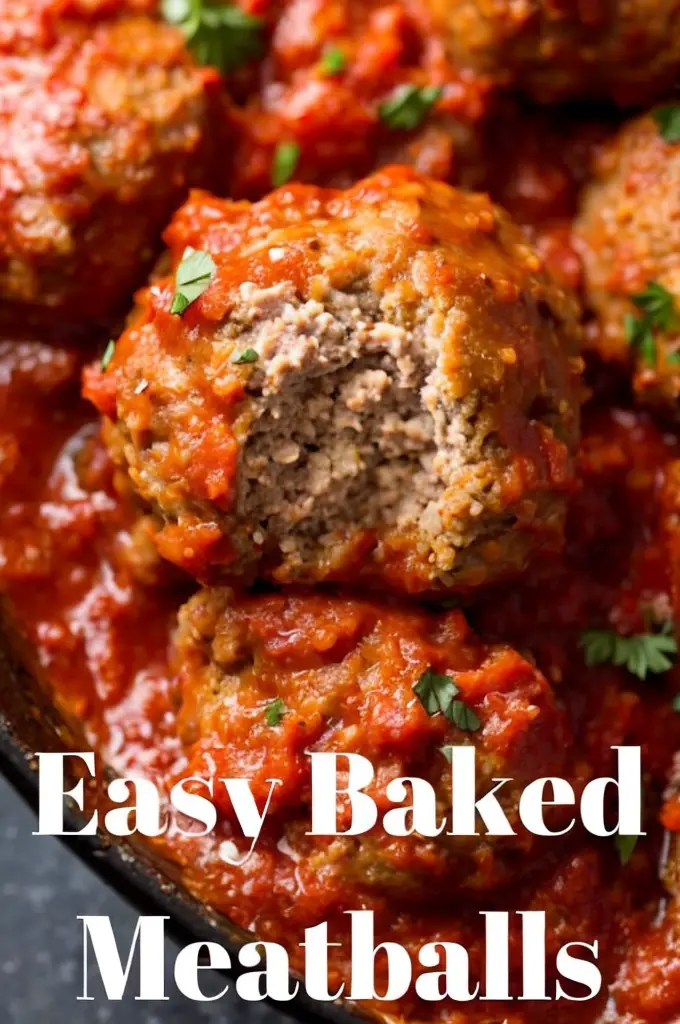Easy Baked Meatballs Recipe: Delicious Comfort in 30 Minutes
Indulge in the savory goodness of our Easy Baked Meatballs, ready in just 30 minutes. This delightful recipe combines succulent flavors and a tender texture, making it a family favorite. Baked to perfection, these meatballs are not just easy to prepare, but they also capture the essence of home-cooked comfort food with minimal effort. Perfect for quick weeknight dinners or meal prep, they embody both convenience and taste.
The aroma of herbs with juicy meat melds beautifully in these baked treasures, promising an appetizing experience that captures the attention of both adults and children alike. This recipe, with its ease and speed, ensures you spend more time enjoying the meal rather than laboring over it. Whether served over spaghetti, mixed with a hearty sauce, or enjoyed standalone with a side of garlic bread, these meatballs are versatile and fit a variety of dining preferences.
Quick Recipe Highlights
- Flavor Profile: A harmonious blend of lightly spiced meat and fragrant herbs for a comforting, umami-rich taste.
- Texture: Juicy and tender on the inside with a slightly crisp outer layer from baking.
- Aroma: Bursting with the savory scents of garlic and Italian seasoning, filling your kitchen with inviting warmth.
- Visual Appeal: Lightly browned and appealing, perfect for topping with freshly chopped parsley.
- Skill Level Needed: Suitable for all levels, from beginners to seasoned cooks due to its straightforward nature.
- Special Equipment: Just a mixing bowl and baking sheet, making cleanup a breeze.
Recipe Overview
- Difficulty Level: This easy level recipe ensures that even those new to cooking can achieve delightful results without complication.
- Category: Ideal as a main dish, appetizer, or even a satisfying snack.
- Cuisine: Inspired by classic Italian flavors, yet versatile enough to adapt to various cuisines.
- Cost: Budget-friendly and made with common pantry items, these meatballs are easy on the wallet but rich in taste.
- Season: Perfect for any season, offering warmth in winter and a light meal option in the warmer months.
- Occasion: Great for family dinners, casual gatherings, or meal prepping for the week.
Why You’ll Love This Recipe
These Easy Baked Meatballs stand out for their unparalleled taste and texture. The way the juices meld with herbs and seasonings creates a mouthwatering umami flavor that’s hard to resist. The mouthfeel is tender yet firm, making every bite a delightful experience. Your family and friends will rave about the taste, making this recipe a staple in your meal rotations.
The convenience factor is undeniable. With just a 10-minute prep and 20-minute bake, you get a hearty meal fast. It’s a lifesaver on busy weeknights, allowing you to deliver quality food without the stress. Not only does this minimize time in the kitchen, but it also means less cleanup afterward, a real win-win for home cooks.
These meatballs pack a nutritional punch, balancing a decent protein content with lower fat options if you choose lean meat. Incorporating healthy herbs not only enhances flavor but also boosts health benefits with their natural properties. It’s a satisfying dish that fits well into balanced diets, effortlessly aligning taste and wellness.
Socially, these meatballs are a hit at gatherings. Their universal appeal cuts across cultural palates, ensuring they’re a go-to dish for guests. They are perfect conversation starters as people will inquire about the delicious aroma emanating from your kitchen.
Finally, these meatballs are economical and accessible. With ingredients that are often already in the pantry or easily obtained from a local store, it ensures cost-effective cooking while not sacrificing on flavor. Simplified cooking meant to fit in your budget while offering top-tier results make this a cherished recipe.
Historical Background and Cultural Significance
The origins of the meatball are as varied as its current iterations across the world. With roots in Italian cuisine, the classic meatball we know today has evolved from its Mediterranean ancestors, where minced meat dishes were prevalent. The concept was largely meant as a method to utilize smaller cuts of meat efficiently.
In Italy, meatballs were initially a way to conserve meat and are known as “polpette.” They quickly became an integral part of Italian-American cuisine, especially in the form of spaghetti and meatballs—a culinary creation that’s since become an international favorite.
Over the years, meatballs have undergone numerous transformations. They’ve seen variations in size, ingredients, and cooking methods as global culinary traditions have mixed. While the traditional Italian recipe sticks to simplistic herbs, region-specific alterations have introduced spices and flavorings from across the world.
Regional variations abound; for instance, Swedish Meatballs offer a creamier, often sweeter counterpart, while Middle Eastern kofta brings bold spices into the fold. Each version tells a unique story of heritage and taste evolution, showcasing cultural significance in culinary diversity.
Ingredient Deep Dive
The choice of meat is the star of any meatball recipe. Ground beef is a favorite for its flavor and richness, though ground pork, chicken, or turkey serve as leaner substitutes. This flexibility in choice accommodates dietary preferences while influencing the final texture and taste of the meatball.
Onion and garlic are indispensable, offering depth and aroma. Chopped finely, they integrate beautifully, ensuring each bite offers a burst of flavor. These age-old ingredients not only serve taste but bring significant health benefits, being rich in antioxidants and compounds beneficial to heart health.
Bread crumbs work as a binding agent, providing structure to the meatball. They envelop the juices as the meat cooks, keeping it tender while absorbing flavor. Fresh or panko breadcrumbs offer different textures, influencing crispness and moisture retention.
Eggs are essential for binding, ensuring the meatballs do not fall apart during the baking process. They also add protein, enhancing the nutritional value. It’s crucial to not overuse them, as it could result in a denser texture, altering the intended lightness.
Herbs and spices round off the flavors. Italian seasoning is a popular choice, blending herbs like oregano, basil, and thyme. Freshly chopped parsley not only adds color but also balances the robust meatiness with a hint of freshness, making each meatball more inviting.
Common Mistakes to Avoid
- Overmixing: This can lead to dense meatballs. Mix just until ingredients are incorporated.
- Using Lean Meat: While healthier, it can dry out. Consider a mixture or add in some fat for juiciness.
- Skipping the Binding: Without enough breadcrumbs or eggs, meatballs fall apart during cooking.
- Ignoring Seasoning: Under-seasoning can lead to blandness. Tasting a small portion before baking can perfect the flavor.
- Overcrowding the Pan: Causes uneven cooking. Give them space for even heat distribution.
- Cooking at High Heat: Leads to dryness. Stick to medium heat for gradual cooking.
- Not Preheating: Ensuring the oven is ready before baking helps achieve consistent results.
- Neglecting Rest Time: Allowing them to rest retains juices, maintaining tenderness.
Essential Techniques
Mastering the technique of mixing the ingredients is crucial. Use your hands to gently combine the mixture, as this prevents over-compactness which can lead to toughness. Ensure all elements are evenly distributed without mashing them into a dense ball.
Perfectly shaping the meatballs impacts their cooking. Use a cookie scoop to ensure uniform size, leading to even cooking times. Visual cues include a slight sheen from binding elements and a uniform surface ensuring even browning.
Baking rather than frying offers a healthier alternative and avoids mess. It entails setting the oven at the right temperature and making sure the meatballs are spaced on the tray to promote even browning.
Pro Tips for Perfect Easy Baked Meatballs
Form the meatballs using a gentle hand; compacting it too much will cause tough end results. If the mixture is sticky, lightly moisten your hands before shaping them.
Consider adding a small amount of grated Parmesan for added depth and an umami hit. It combines perfectly with the inherent meatiness, elevating flavor without overpowering other herbs.
For even more flavor, a small pinch of red pepper flakes can introduce a subtle heat without being overwhelming. It dances across the palate adding complexity to each bite.
Fresh herbs lend a brightly flavored dimension. Consider using fresh parsley and perhaps some thyme right before baking for a vibrant touch that dried herbs can’t replicate in full.
To ensure juiciness, some cooks add a small splash of milk to the mixture, effectively moistening it from inside and yielding tender results.
Rest the meatballs post-baking. Allowing them a brief cooling period before serving helps keep them juicy while intensifying the delicious flavors.
Variations and Adaptations
Regional variations abound. Italian meatballs often feature ingredients like Pecorino Romano, while Swedish versions incorporate cream and hint at sweet elements like nutmeg or allspice, creating a creamy counterpart.
For seasonal adaptations, consider using seasonal herbs or vegetables. Roasted vegetables mixed in during fall, or a summer-inspired citrus zest can bring a fresh take on the dish.
Dietary modifications offer flexibility. Use gluten-free breadcrumbs for a gluten-free version, or swap the egg with a chia substitute for a vegan adaptation.
Flavor variations can come with the use of cheese, such as feta or cheddar mixed in, adding layers of complex flavor appealing to diverse palates.
Texture modifications can be achieved by adjusting breadcrumb coarseness. A coarser crumb offers more texture, while a finer one smooths it out for a delicate bite.
Presentation alternatives include skewering smaller, cocktail-sized meatballs for canapés or serving over a bed of vibrant garden-fresh greens for a modern twist.
Serving and Presentation Guide
Plating these meatballs in a bowl with fresh tomato sauce over cooked pasta offers a traditional allure, capturing the spirit of Italian dining perfectly.
Garnishing suggestions include freshly chopped parsley, a drizzle of olive oil, or shaved Parmesan. These choices accentuate visuals while offering richness.
Traditional accompaniments include a side of crusty bread, pairing perfectly with the tender meatballs and inviting sauce for a delightful interplay of textures.
Modern serving suggestions include placing atop cauliflower mash for a low-carb variant or creating sliders with colorful slaw for a contemporary spin.
Temperature considerations ensure these meatballs maintain their appeal. They should be served warm, but not piping hot, to fully appreciate the layered flavors.
Portion control tips include making smaller-sized meatballs for appetizers or pre-portioning into bowls for gatherings to ensure consistent serving sizes.
Wine and Beverage Pairing
A robust red wine like Chianti or Sangiovese complements the meatiness of these meatballs, enhancing the herbs and enriching the dining experience.
Non-alcoholic alternatives, such as a sparkling water with a splash of lemon, work to cleanse the palate, offering a refreshing balance to the dish’s richness.
If serving with pasta, a crisp white like Pinot Grigio can offset the tomato’s acidity while supporting the meatballs’ robust flavors with grace.
Temperature considerations mean serving beverages chilled, at roughly 45-55°F, for heightened refreshment and contrast against warm meatballs.
Serving suggestions include garnishing the wine glass rim with a thin slice of citrus, introducing both a visual and aromatic element to the dining experience.
Storage and Shelf Life
Store these in an airtight container within the fridge for up to 3 days, ensuring they remain tender and flavorful. Proper sealing keeps them from absorbing unwanted fridge odors.
They should be kept at a consistent 40°F or lower for safety. Avoid drastic temperature swings that could prompt bacterial growth or spoilage.
Opt for glass containers to maintain flavor integrity without odor influence, ensuring they remain fresh tasting when ready to reheat.
Signs of spoilage include off odors and a slimy texture. Discard any meatballs that exhibit these characteristics for safety.
Reheating instructions suggest using an oven or stovetop for a crisped exterior, reviving the warmth without drying out the meatballs.
For long-term storage, freezing is advisable. First, flash-freeze on a tray and then transfer to a freezer bag for up to 3 months, ensuring they stay separated and easy to reheat.
Make Ahead Strategies
Prepare meatballs up to stage of forming into balls, then freeze them raw. This allows for quick, oven-to-table meals when time is of the essence with minimal prep.
Between steps, it’s crucial to keep the meatballs cool. Chill them for up to 24 hours before cooking, ensuring they maintain optimal texture and taste.
Assess the quality impact, noting that pre-prepping allows for deeper flavor penetration as spices infuse with the proteins, enriching the end result.
Assembly tips include forming, covering, and stacking them with parchment between layers to avoid sticking or misshaping.
Reheating guidelines favor slow methods such as oven warming to maintain juiciness. Avoid microwave use to prevent rubbery textures.
Fresh element additions such as herbs or finishing Parmesan should be left till serving, maximizing freshness and visual appeal.
Scaling Instructions
To halve the recipe, maintain ingredient ratios. For example, blend half the amount of breadcrumbs, yet keep one egg to ensure proper binding.
Doubling involves simple multiplication, ensuring enough mixing space is provided to avoid spillover. Larger trays might be necessary for cooking all at once.
Equipment adjustments, like using larger mixing bowls or multiple baking sheets, accommodate increased volume without compromising cooking quality.
Timing modifications involve checking doneness, particularly if tray density changes. Add a few minutes if doubling to account for increased heat distribution needs.
Storage considerations should accommodate the bulk by freezing in portions or separate containers to maintain use ease and freshness.
Nutritional Deep Dive
Macro breakdown reveals a high protein profile, around 20 grams per serving, supporting muscle maintenance and energy presence post meal.
Micronutrient analysis boosts focus on iron and Vitamin B12, both crucial in promoting healthy red blood cells and maintaining nerve health.
Health benefits include supporting balanced nutrition by using leaner meat options, ensuring lower saturated fat with maintained protein intake vital for energy.
Dietary considerations recommend these meatballs as a great source of protein for active individuals, along with substantial minerals for essential bodily functions.
Portion analysis implies balance with accompanying smaller sides, allowing room for increased vegetables or simpler starches, ensuring comprehensive nutrient delivery.
Weight management tips highlight using a leaner mix of meat and slight breadcrumb reduction to increase protein density without increasing caloric intake.
Dietary Adaptations
For gluten-free, substitute conventional breadcrumbs with gluten-free options like rice crumbs or ground oats, maintaining mix integrity without compromising texture.
Dairy-free versions simply omit cheese, ensuring the remaining herb and garlic palette remain vibrant yet lactose-free.
Vegan adaptations suggest alternatives such as using lentils or beans instead of meat, adding ample minced mushrooms or egg substitute for a protein-rich flavor.
For low-carb enthusiasts, consider cheese and almond flour to bind, maintaining flavor while lowering carb intake significantly.
Keto-conscious adjustments align with low-carb, high-fat diets, involving high-fat cheese or avocado blend for creamy, ketogenic-friendly substitutes.
Paleo-friends benefit from avoiding breadcrumbs completely, using almond flour or cassava flour, leveraging their binding qualities without gluten content.
Low-FODMAP approaches remove onion and garlic, leaning into scallion greens or chive infusions, maintaining flavor within dietary restrictions.
The Recipe
Easy Baked Meatballs
Serves: 4
Prep Time: 10 mins
Cook Time: 20 mins
Total Time: 30 mins
Kitchen Equipment Needed
- Mixing Bowl
- Large Baking Sheet
- Measuring Spoons
- Cookie Scoop
Ingredients
- 1 lb ground beef
- 1/4 cup breadcrumbs
- 1/4 cup grated Parmesan cheese
- 1 egg
- 2 cloves garlic, minced
- 1 tbsp Italian seasoning
- Salt and Pepper to taste
- 2 tbsp fresh parsley, chopped
Directions
- Preheat your oven to 400°F (200°C).
- In a large mixing bowl, combine ground beef, breadcrumbs, Parmesan cheese, egg, minced garlic, Italian seasoning, salt, and pepper.
- Using your hands, mix until well combined, being careful not to overwork the mixture.
- Shape the mixture into 1-inch balls, arranging them evenly on a baking sheet.
- Bake in the preheated oven for 20 minutes or until the internal temperature reaches 165°F.
- Sprinkle with fresh parsley before serving, enjoy warm.
Recipe Notes
- If preferred, substitute the ground beef with turkey for a leaner option.
- For a spicier kick, add red pepper flakes to the mixture.
- Make meatballs ahead of time and freeze for a quick meal later.
Troubleshooting Guide
If experiencing texture issues, ensure you’re not over-mixing the ingredients; this can overly compact the meatball, making it dense.
Flavor balance problems can often be solved with simple seasoning adjustments. A taste-test pre-baking allows for finer tweaking.
Temperature problems often stem from oven miscalibration. Use an oven thermometer to guarantee accurate settings.
Equipment challenges solve themselves with correct tools: a cookie scoop ensures equal portions for organized baking.
Ingredient substitutions should note flavor and textural impact. If using turkey instead of beef, consider increasing herb quantities for greater depth.
Timing concerns require attention to size and spacing during baking. Uniformity ensures even cooking, lessening the requirement for time adjustments.
Recipe Success Stories
Community feedback highlights these meatballs as crowd-pleasers, praised for adaptability while fitting diverse tastes among guests and family members alike.
Variation successes span from sweeter notes with a hint of honey to substitutions like duck for richer, special-occasion alternatives, celebrated widely online.
Adaptation stories include excellent vegetarian takes using chickpeas, adored for unique textures and impressive flavor capabilities introduced by cumin.
Reader suggestions have expanded horizons to include cheese-stuffed meatballs, promptly receiving acclaim for innovative spins on a classic dish.
Photography tips suggest capturing the vibrant meatball garnished with fresh parsley. Utilize natural light to highlight the savory and inviting dish.
Frequently Asked Questions
What’s the best meat for meatballs?
While ground beef is traditional, mixtures including pork, turkey, or chicken offer varying fat content influencing flavor and juiciness, depending on preference.
Can I freeze meatballs?
Absolutely. Freeze them raw or cooked; both ways maintain quality when reheated properly, providing convenience for future meal planning.
How do I prevent meatballs from drying out?
Utilize a mix of meats with slightly higher fat content or carefully measure binding ingredients, adding moisture potential back to the recipe.
Why are my meatballs falling apart?
Ensure enough binding agent, like breadcrumbs or egg, is included. Balance dry-to-wet ingredients correctly for cohesive mixture structure.
What makes these meatballs juicy?
Fat content, proper seasoning, and the right breadcrumb ratio significantly impact juiciness, retaining flavor throughout the cooking process.
Can I make these ahead of time?
Yes, assemble at any point prior to baking, refrigerate or freeze, and then bake off whenever needed for fresh results at any moment.
What’s a suitable accompanying dish?
Pasta is a classic choice, or consider mashed potatoes, a fresh salad, or even freshly toasted bread for comprehensive mealtime satisfaction.
Any vegetarian options?
Chickpeas and mushrooms act as excellent stand-ins for meat, providing robust flavor and texture with common spice adaptation for new dimension.
How do I store leftovers?
Place them in an airtight container within refrigeration, ensuring freshness. Reheat gently to prevent moisture loss and maintain dining quality.
Can I use an air fryer instead?
Indeed. This method offers a rapid cooking alternative with crisp results. Set the air fryer to 375°F and check doneness at about halfway through.
Additional Resources
Explore an array of complementary recipes such as various sauces and handmade pasta to pair with your meatballs for varied flavor experiences.
Technique guides may offer refinement to basics, such as effective meat mixing, seasoning balance, and baking adjustments altering recipe quality notably.
Ingredient information dives into nutrition profiles, sourcing ethics, and preparation tips ensuring the highest quality use of fresh, accessible foods.
Equipment recommendations specify items like thermometers and premium cookware enhancing cooking outcomes through accuracy and heat efficiency.
Seasonal variations suggest tailoring recipes across different times of year for optimal freshness, inspired by available herbs, vegetables, and resulting flavor palettes.
Join the Conversation
Engage with our culinary community through social media, sharing your own variations and successes, complete with vibrant images of your cooking creations.
Photography tips can aid in highlighting the appeal of freshly cooked dishes, emphasizing the artistry inherent in the craft of meal presentation.
Submit reviews for shared learning from attempts at this recipe, promoting a cycle of improvement through constructive feedback made by your fellow readers.
Join interactive forums to discuss potential variations, engage in answering questions about techniques or ingredient uses, valuing shared expertise among peers.
Challenge variations to improve upon traditional methods, joining in the evolution of timeless recipes through modern, communal inspiration and participation.






